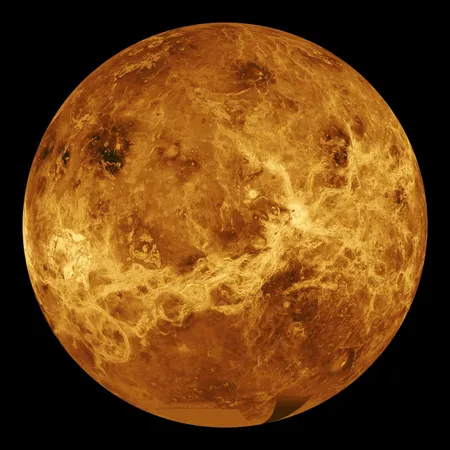
Shocking Discovery: Venus's Crust is Thinner Than We Thought!
2025-05-09
Author: Ming
Groundbreaking Research Unveils Surprising Geological Secrets of Venus
Recent studies have uncovered some astonishing details about Venus, Earth's fiery twin, proving that its geology is far more complex than previously believed. A new paper published in Nature Communications reveals unexpected insights into the dynamics of Venus's crust.
Expectations vs. Reality: The Thin Crust of Venus
Scientists assumed that the crust of Venus would continually thicken over time, especially given its apparent lack of forces that push crust back into the planet. However, researchers have proposed a novel metamorphism process that involves rock density and melting cycles, challenging what we once thought.
Plate Tectonics on Earth vs. The Unyielding Crust of Venus
On Earth, our rocky crust is characterized by massive plates that move slowly and create geological features like folds and faults—a phenomenon known as plate tectonics. In contrast, Venus presents a starkly different picture: its crust is an uninterrupted slab with no signs of subduction, the process that drives Earth's geological activity.
Justin Filiberto, deputy chief at NASA's Astromaterials Research and Exploration Science Division, explains that their modeling indicates Venus's crust averages about 25 miles (40 kilometers) thick, reaching a maximum of only 40 miles (65 kilometers). This is surprisingly thin considering the extreme conditions found on the planet!
The Metamorphic Dilemma: How Crustal Density Affects Volcanism
"As the crust thickens, it becomes so dense that it either breaks off into the mantle or gets hot enough to melt," says Filiberto. This unique behavior suggests that even without moving tectonic plates, Venus's crust undergoes metamorphism. This finding not only reshapes our understanding of Venus's geological processes but also holds clues about volcanic activity.
Implications for Volcanism: A New Cycle of Activity?
The breaking off or melting of crustal material could inject water and essential elements back into Venus's interior, fueling volcanic activity. Filiberto notes, "This concept gives us a fresh perspective on how material is cycled back into the planet and helps generate lava, potentially sparking eruptions." It’s a game changer for understanding the interconnectedness of Venus's geology, atmosphere, and volcanic behavior.
What's Next? Exciting Missions to Venus!
Moving forward, researchers are eager to obtain direct data about Venus's crust to further validate and refine these models. Upcoming missions like NASA's DAVINCI and VERITAS, along with the European Space Agency's Envision project, are set to explore the Venusian surface and atmosphere in unprecedented detail.
These ambitious efforts could actively confirm whether the processes of metamorphism and recycling are shaping the Venusian crust today, shedding light on its volcanic and atmospheric evolution.


 Brasil (PT)
Brasil (PT)
 Canada (EN)
Canada (EN)
 Chile (ES)
Chile (ES)
 Česko (CS)
Česko (CS)
 대한민국 (KO)
대한민국 (KO)
 España (ES)
España (ES)
 France (FR)
France (FR)
 Hong Kong (EN)
Hong Kong (EN)
 Italia (IT)
Italia (IT)
 日本 (JA)
日本 (JA)
 Magyarország (HU)
Magyarország (HU)
 Norge (NO)
Norge (NO)
 Polska (PL)
Polska (PL)
 Schweiz (DE)
Schweiz (DE)
 Singapore (EN)
Singapore (EN)
 Sverige (SV)
Sverige (SV)
 Suomi (FI)
Suomi (FI)
 Türkiye (TR)
Türkiye (TR)
 الإمارات العربية المتحدة (AR)
الإمارات العربية المتحدة (AR)